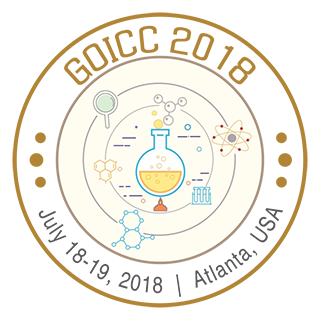Mohammad H. Alotaibi
King Abdulaziz City for Science and Technology, Kingdom of Saudi Arabia
Title: Hydrogen generation from formic acid decomposition using a Iradium-Palladium (Ir-Pd) nanoparticles supported on different supports
Biography
Biography: Mohammad H. Alotaibi
Abstract
Introduction: In recent years, attention was turned to hydrogen generation and their importance rule in future energy and for storage/generation for fuel-cells-based H2. Formic acid (HCOOH) is the main product from biomass processing has important possess such as handled safely in aqueous solution, high-energy density, non-toxic material, high energy density and excellent stability at room temperature. Two expected pathways for the decompositions of formic acid, dehydrogenation to produce hydrogen (H2) and carbon dioxide (CO2) which shows in equation 1, and dehydrogenation to produce carbon monoxide (CO) with water (equation 2).
![]() HCOOH (l) H2 (g) + CO2 (g) ∆G298K= - 35.0 kJmol -1 (Equation 1)
HCOOH (l) H2 (g) + CO2 (g) ∆G298K= - 35.0 kJmol -1 (Equation 1)
![]() HCOOH (l) H2O (l) + CO (g) ∆G298K= - 14.9 kJmol -1 (Equation 2)
HCOOH (l) H2O (l) + CO (g) ∆G298K= - 14.9 kJmol -1 (Equation 2)
Production of CO can poison the catalyst. Therefore, it is important to find catalyst can push the reaction selectively to follow the first pathway.
Experimental/methodology: (0.5, 1 and 2 % mole) of Ir using iridium chloride obtain from (Sigma-Aldrich) were mixed with 15% Hydrochloric acid in a flask under stirring and heating at 80 °C, and 3 g active carbon or TiO2 obtained from (Alpha Chemical) was then added. The mixtures were continuously stirred and heated at 80 °C overnight, then washed with distilled water several times and dried at 100 °C overnight. Then, the final catalysts were calcined and reduced at 400 °C for 4 h. Furthermore, (2.5 % mole ratio) of Ir using iridium chloride obtain from (Sigma-Aldrich) and Pd (0.5, 1 and 2 % mole ratio) using Pd acetate obtained from (Sigma-Aldrich) were mixed with 15% Hydrochloric acid in a flask under stirring and heating at 80 °C, and 3 g active carbon or TiO2 obtained from (Alpha Chemical) was then added. The mixtures were continuously stirred and heated at 80 °C overnight, then washed with distilled water Several times and dried at 100 °C overnight. Then, the final catalysts were calcined and reduced at 400 °C for 4 h.
Results and discussion: In this investigation, we aim to study the effect of Iridium and Palladium noble metals supported on two different supports for the decompositions of formic acid. Several catalysts of supported Iridium and Palladium with different metal ratio have been prepared by impregnation method. The physicochemical properties of the prepared catalysts were characterized with XRD, TEM, EDS, IR, UV, and BET. These catalysts were tested for the decompositions of formic acid using liquid phase reaction. The reaction conditions were decomposition of 10 ml of diluted formic acid (0.5 M, 0,005 mol) on the known amount of the catalyst with ratio 1:1000. The reaction temperature was varied and that for 4 hours reaction time. In conclusion, Ir and Pd bimetallic show very strong interaction and exhibited a good stability and high activity for the decomposition of formic acid to produce hydrogen.

